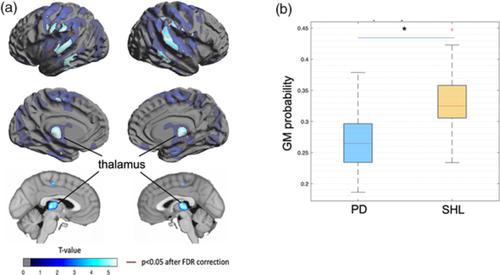当前位置:
X-MOL 学术
›
Hum. Brain Mapp.
›
论文详情
Our official English website, www.x-mol.net, welcomes your feedback! (Note: you will need to create a separate account there.)
Cortical reorganization following auditory deprivation predicts cochlear implant performance in postlingually deaf adults
Human Brain Mapping ( IF 4.8 ) Pub Date : 2020-10-06 , DOI: 10.1002/hbm.25219 Zhe Sun 1 , Ji Won Seo 2 , Hong Ju Park 3 , Jee Yeon Lee 3 , Min Young Kwak 3 , Yehree Kim 3 , Je Yeon Lee 4 , Jun Woo Park 3 , Woo Seok Kang 3 , Joong Ho Ahn 3 , Jong Woo Chung 3 , Hosung Kim 1
Human Brain Mapping ( IF 4.8 ) Pub Date : 2020-10-06 , DOI: 10.1002/hbm.25219 Zhe Sun 1 , Ji Won Seo 2 , Hong Ju Park 3 , Jee Yeon Lee 3 , Min Young Kwak 3 , Yehree Kim 3 , Je Yeon Lee 4 , Jun Woo Park 3 , Woo Seok Kang 3 , Joong Ho Ahn 3 , Jong Woo Chung 3 , Hosung Kim 1
Affiliation

|
Long‐term hearing loss in postlingually deaf (PD) adults may lead to brain structural changes that affect the outcomes of cochlear implantation. We studied 94 PD patients who underwent cochlear implantation and 37 patients who were MRI‐scanned within 2 weeks after the onset of sudden hearing loss and expected with minimal brain structural changes in relation to deafness. Compared with those with sudden hearing loss, we found lower gray matter (GM) probabilities in bilateral thalami, superior, middle, inferior temporal cortices as well as the central cortical regions corresponding to the movement and sensation of the lips, tongue, and larynx in the PD group. Among these brain areas, the GM in the middle temporal cortex showed negative correlation with disease duration, whereas the other areas displayed positive correlations. Left superior, middle temporal cortical, and bilateral thalamic GMs were the most accurate predictors of post‐cochlear implantation word recognition scores (mean absolute error [MAE] = 10.1, r = .82), which was superior to clinical variables used (MAE: 12.1, p < .05). Using the combined brain morphological and clinical features, we achieved the best prediction of the outcome (MAE: 8.51, r = .90). Our findings suggest that the cross‐modal plasticity allowing the superior temporal cortex and thalamus to process other modal sensory inputs reverses the initially lower volume when deafness becomes persistent. The middle temporal cortex processing higher‐level language comprehension shows persistent negative correlations with disease duration, suggesting this area's association with degraded speech comprehensions due to long‐term deafness. Morphological features combined with clinical variables might play a key role in predicting outcomes of cochlear implantation.
中文翻译:

听觉剥夺后的皮质重组可预测语后聋成人的人工耳蜗性能
语后聋 (PD) 成人的长期听力损失可能会导致影响人工耳蜗植入结果的大脑结构变化。我们研究了 94 名接受人工耳蜗植入的 PD 患者和 37 名在突发听力损失发作后 2 周内接受 MRI 扫描的患者,预计与耳聋相关的脑结构变化很小。与突发性听力损失的患者相比,我们发现双侧丘脑、上、中、下颞叶皮质以及与嘴唇、舌头和喉部的运动和感觉相对应的中央皮质区域的灰质(GM)概率较低。 PD组。在这些脑区中,中颞叶皮层的GM与病程呈负相关,而其他区域则呈正相关。左上级,r = .82),优于使用的临床变量(MAE:12.1,p < .05)。结合脑形态学和临床特征,我们实现了对结果的最佳预测(MAE:8.51,r = .90)。我们的研究结果表明,当耳聋持续时,允许上颞叶皮层和丘脑处理其他模态感觉输入的跨模态可塑性逆转了最初较低的音量。处理高级语言理解的中颞叶皮层显示出与疾病持续时间的持续负相关,表明该区域与长期耳聋导致的语言理解能力下降有关。形态特征与临床变量相结合可能在预测人工耳蜗植入的结果中起关键作用。
更新日期:2020-12-08
中文翻译:

听觉剥夺后的皮质重组可预测语后聋成人的人工耳蜗性能
语后聋 (PD) 成人的长期听力损失可能会导致影响人工耳蜗植入结果的大脑结构变化。我们研究了 94 名接受人工耳蜗植入的 PD 患者和 37 名在突发听力损失发作后 2 周内接受 MRI 扫描的患者,预计与耳聋相关的脑结构变化很小。与突发性听力损失的患者相比,我们发现双侧丘脑、上、中、下颞叶皮质以及与嘴唇、舌头和喉部的运动和感觉相对应的中央皮质区域的灰质(GM)概率较低。 PD组。在这些脑区中,中颞叶皮层的GM与病程呈负相关,而其他区域则呈正相关。左上级,r = .82),优于使用的临床变量(MAE:12.1,p < .05)。结合脑形态学和临床特征,我们实现了对结果的最佳预测(MAE:8.51,r = .90)。我们的研究结果表明,当耳聋持续时,允许上颞叶皮层和丘脑处理其他模态感觉输入的跨模态可塑性逆转了最初较低的音量。处理高级语言理解的中颞叶皮层显示出与疾病持续时间的持续负相关,表明该区域与长期耳聋导致的语言理解能力下降有关。形态特征与临床变量相结合可能在预测人工耳蜗植入的结果中起关键作用。


























 京公网安备 11010802027423号
京公网安备 11010802027423号